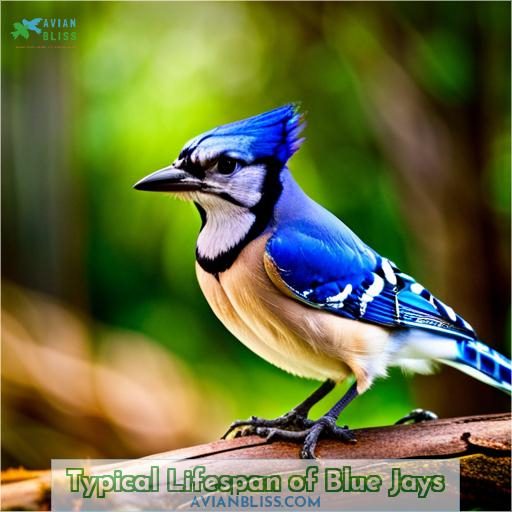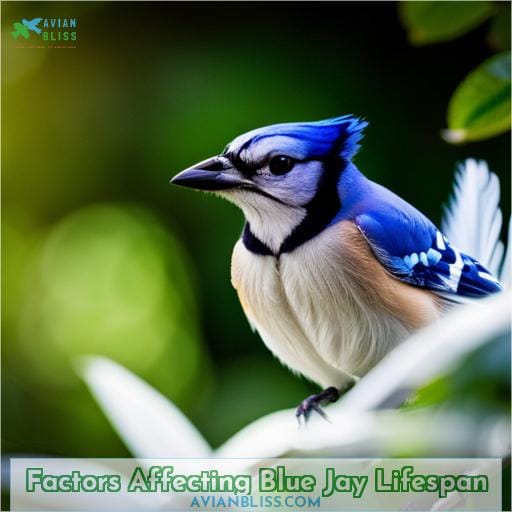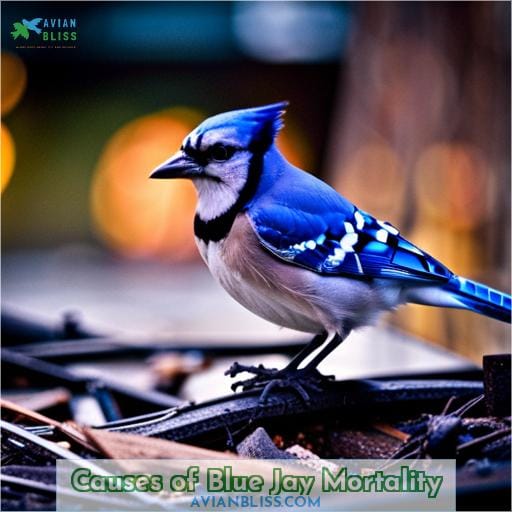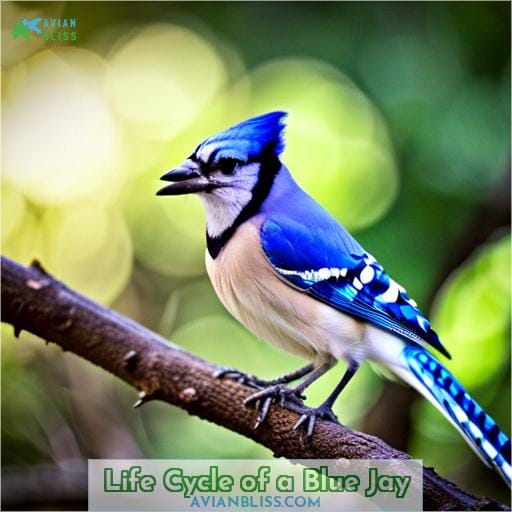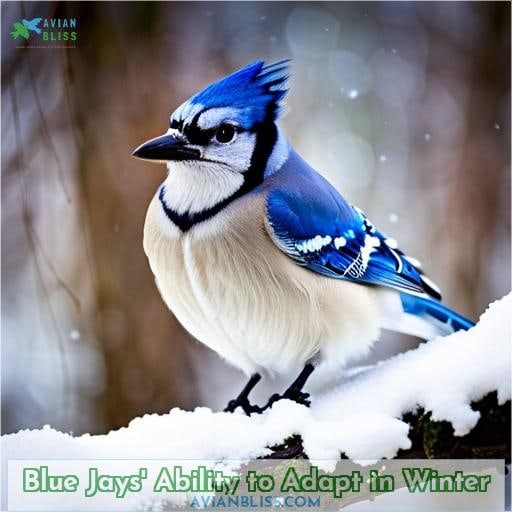This site is supported by our readers. We may earn a commission, at no cost to you, if you purchase through links.
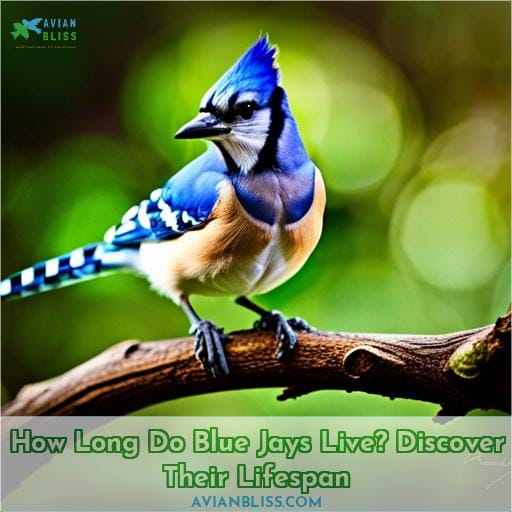
These iconic blue-hued birds, native to North America, hold a captivating tale of existence. From the wild woodlands to the confined boundaries of captivity, their lifespans vary, raising intriguing questions about what truly influences their survival.
Delve into the intricate web of nature’s design as we uncover the secrets behind how long blue jays truly live.
Table Of Contents
- Key Takeaways
- Typical Lifespan of Blue Jays
- Factors Affecting Blue Jay Lifespan
- Causes of Blue Jay Mortality
- Life Cycle of a Blue Jay
- Aging Blue Jays
- Predators of Blue Jays
- Longest Recorded Lifespan of a Blue Jay
- Blue Jay Survival Without Food
- Blue Jays’ Ability to Adapt in Winter
- Factors Contributing to Blue Jay Longevity
- Conclusion
Key Takeaways
- The average lifespan of blue jays in the wild is 7 years.
- Blue jays can live up to 17 years and 6 months in the wild.
- Blue jays can live up to 26 years and 3 months in captivity.
- Factors influencing blue jay lifespan include environmental influences, genetic factors, food availability, and predation risk.
Typical Lifespan of Blue Jays
Exploring the fascinating lifespan of blue jays unveils intriguing distinctions between their wild and captive existences. In the wild, these vibrant avians boast an average lifespan of approximately 7 years, with the oldest recorded individual enduring for an impressive 17 years and 6 months.
On the other hand, within the sheltered realm of captivity, a female blue jay remarkably thrived for an astonishing 26 years and 3 months, underscoring the potential longevity these captivating creatures can attain when shielded from the challenges of their natural environment.
In the Wild
Amidst the diverse landscapes they call home, blue jays carve out their journeys, navigating survival challenges beneath woodland’s vast canopy. In the wild, they exhibit environmental resilience, adapting to winter conditions through foraging for seeds, nuts, and insects.
Their reproductive patterns involve monogamous bonds, shared incubation of 17-18 days, and fledging after 17-21 days. Vocal communication and mimicry of hawks aid their survival against predators, shaping a story of freedom and adaptability.
In Captivity
Nurtured within the confines of human care, these captivating creatures spread their wings and defy the grasp of time, embracing an existence beyond their woodland realm. In captivity, blue jays enjoy a prolonged lifespan compared to their wild counterparts.
With access to a controlled environment enriched with varied activities and social interactions, coupled with a balanced diet and regular veterinary care, the oldest recorded blue jay reached an impressive 26 years.
Factors Affecting Blue Jay Lifespan
To extend the lifespan of these birds, ensuring a consistent supply of food and suitable nesting sites is crucial. Blue jays, with their distinctive blue plumage and unique behaviors, can live up to seven years on average.
Environmental Influences: Blue jays are adaptable but are impacted by habitat loss and urbanization. Protecting their natural habitats is essential.
Genetic Factors: Individual genetic variations can affect a blue jay’s lifespan. Some may be genetically predisposed to live longer.
Food Availability: Access to a diverse diet of fruits, nuts, seeds, and insects is vital. Human actions that impact their food sources can affect their survival.
Predation Risk: Blue jays face threats from predators like hawks and raccoons. Avoiding predation is crucial for their survival.
Climate Effects: Harsh winters can be challenging, but blue jays are resilient. However, extreme climate events can impact their ability to find food.
Understanding these factors and taking steps to protect blue jays and their ecosystem role is essential, especially as they’re not currently endangered.
Causes of Blue Jay Mortality
While blue jays have the potential to thrive for up to 17.5 years in favorable conditions, their longevity is often influenced by a complex interplay of factors. These charismatic birds are not exempt from the challenges that confront them in their environment.
Their vibrant presence in both wooded landscapes and urban settings exposes them to diverse hazards.
Predator interactions with hawks, owls, and mammals often threaten their existence. Environmental stressors, coupled with disease impact, can further compromise their survival. Urban habitat challenges, including habitat loss and human activities, add additional pressures.
Even food availability, especially during harsh winters, can significantly shape their lifespan.
Yet, protection under the Migratory Bird Treaty Act provides a degree of security. These remarkable creatures, with their mosaic-like feathers and intriguing behaviors like paint chip collection, continue to navigate these challenges as they adapt to the ever-changing world around them.
Life Cycle of a Blue Jay
Moving into the realm of blue jay life cycles, you’ll find their journey marked by fascinating stages. As these vibrant birds reach maturity around their first year, they form lifelong bonds, embarking on a breeding season that spans from late April to July.
During this time, they collaborate in nest-building, with both parents playing pivotal roles in raising their young. The nesting process involves carefully crafting loose nests from twigs, leaves, and grasses, where females lay a clutch of 3 to 6 eggs adorned with diverse colors and spots.
With a shared incubation period of 17 to 18 days, both partners dedicate themselves to nurturing the future generation. And when the moment arrives, their fledglings take their first flight after 17 to 21 days, remaining under their parents’ guidance for about two months, establishing a pattern of commitment and care that’s intrinsic to the blue jay life cycle.
Maturity and Reproduction
Reaching maturity within about a year, blue jays form monogamous bonds that last a lifetime. Their nesting behavior is characterized by loose nests made of twigs, leaves, and grasses. Both parents share the responsibility of incubating the 3 to 6 eggs, which display a variety of colors with spots.
This devoted parental care continues as they raise their young, providing them a safe start in their vibrant, intricate world.
Nesting and Fledging
In the world of these vibrant birds, their nests, crafted with twigs and grasses, become bustling hubs of activity as their young ones prepare for the great leap into independence. The adult blue jays meticulously build their nests, ensuring they provide a safe haven for their precious eggs.
Once hatched, the parents devote themselves to round-the-clock care, diligently feeding and protecting their vulnerable fledglings. Despite the challenges of predation and environmental factors, many nests achieve success, with the dedicated parental care playing a crucial role in the survival of the next generation.
Aging Blue Jays
Transitioning from the life cycle of a Blue Jay, let’s delve into the intriguing process of aging these vibrant creatures.
The Blue Jay’s lifespan, averaging around 7 years in the wild, can vary based on factors like predation, environment, and food availability. The analysis of their longevity often involves examining growth rings in their feathers, which can provide insight into their age, much like the rings of a tree trunk.
The senescence patterns in Blue Jays reveal that, similar to many creatures, they experience physical changes as they age, which might impact their ability to forage and defend themselves. Age determination methods, including feather characteristics and overall health, contribute to our understanding of how these birds navigate their aging process.
Predators of Blue Jays
Facing an array of challenges in the wild, blue jays navigate the complex web of predators and human influences. Their lives intertwine with those of hawks, owls, and other natural foes, while the impacts of human activity also cast a shadow on their existence.
Natural Predators
Beneath the watchful eyes of the sky’s skilled hunters, survival becomes an art for these vibrant avian inhabitants of woodlands and gardens. Owl predation poses a nocturnal threat, forcing blue jays to employ their mosaic-like plumage as camouflage.
Crow gangs present daytime challenges, while raccoons prowl for vulnerable nests. The hawk’s influence triggers mimicry, offering a defensive cloak. Through tactical adaptations, these jays navigate the intricate dance of life and danger.
Human Impact
Amidst the tapestry of intriguing facts about these avian creatures, your impact on their world emerges as a vital thread woven into their story. Blue jays in urban environments face a complex interplay of human interaction and their natural behaviors.
Conservation efforts become imperative to safeguard their habitats against the encroachment of urbanization. Pollution effects and human disturbances further underscore the necessity of coexisting harmoniously to ensure their survival.
Longest Recorded Lifespan of a Blue Jay
Transitioning from the discussion on predators, it’s fascinating to explore the longevity of blue jays. These birds, known for their distinctive appearance and behaviors, also possess intriguing insights into their aging process.
Blue Jay longevity is influenced by various factors, ranging from genetic predisposition to environmental influences. Exceptional lifespan instances highlight the resilience of these birds in the face of challenges posed by predators and changing habitats.
Understanding the intricacies of Blue Jay longevity factors provides valuable information about their ability to adapt and thrive.
It’s remarkable how they navigate the intricacies of survival, balancing their roles as both prey and predator. By delving into the secrets of their exceptional lifespans, we gain a glimpse into the intricate tapestry of nature’s design, a testament to the complexity of life’s journey.
Blue Jay Survival Without Food
Imagine a world where survival hinges on adapting to winter’s cold grasp, where the vibrant mosaic of feathers finds itself challenged by harsh elements. Blue jays, those resplendent aviators, employ ingenious survival strategies to brave food scarcity and bitter cold.
Their winter foraging instincts kick into gear, scouring the landscape for hidden caches of seeds, nuts, and insects. As the days grow shorter, these birds exhibit remarkable cold weather adaptations. They fluff up their feathers to trap heat, utilizing their crested head to minimize heat loss.
Their feeding behavior becomes deliberate, conserving energy as they carefully select high-calorie foods.
A deep-seated resilience allows them to thrive amid the frosty season, embodying the yearning for understanding, safety, and freedom in the face of nature’s trials.
Blue Jays’ Ability to Adapt in Winter
Embracing the winter chill, these charismatic birds gracefully adapt, venturing through frost-covered landscapes in search of sustenance. Blue jays, known for their vivid plumage and distinctive calls, employ a range of feeding strategies to endure the cold months.
Their omnivorous diet shifts as they forage for seeds, nuts, and insects during the daylight hours. Their resilient nature shines as they efficiently utilize their keen eyesight to spot hidden food sources.
Seasonal adaptations are key to their survival; caching food during abundant times helps sustain them when resources are scarce. They navigate the snow-covered terrain with dexterity, relying on their innate ability to find and store food.
Blue jays’ cold resilience and strategic foraging techniques demonstrate their mastery in thriving amidst winter’s challenges.
Factors Contributing to Blue Jay Longevity
To underscore the significance of a particular notion, examine the validity of the anting theory. Blue jays might not only be minimizing the acidity of ants but also enhancing their survival odds through this curious behavior.
Genetic factors play a substantial role in their longevity. Inherited traits affect their ability to adapt to various challenges. Environmental conditions further shape their lifespan. Access to resources and protection from predators directly impact their survival.
Diet variety is an important aspect that ensures they acquire essential nutrients for sustained health. Social bonding contributes to emotional well-being, indirectly influencing lifespan. This is evidenced by their monogamous pair bonds. Lastly, successful reproduction ensures the continuation of their DNA lineage, making longevity an imperative.
Conclusion
In closing, ponder the blue jay’s lifespan, akin to a story etched in nature’s pages. These azure wonders, with their vibrant plumage and mimicry prowess, endure the wild for around 7 years. Yet, under the guardianship of captivity, one soared to an astonishing 26 years and 3 months, showcasing the impact of environment.
Predators, both wild and human, cast shadows over their journey, underscoring the fragility of existence. As seasons turn, these resilient beings adapt and thrive in the face of winter’s chill. Delve into their world, for within it lies a tale of survival, resilience, and the enduring melody of life.
So, how long do blue jays live? The answer, like the sky they traverse, is a testament to the intricate dance of time and nature.

